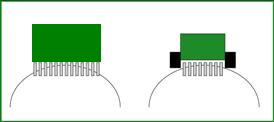Do you mow your greens with a 56-cm (22-in.) cutting unit, or do you mow them
with a 76-cm (30-in.) cutting unit? Most will agree that greens are mowed with 56-cm (22-in.) cutting units, or maybe even 45.7-cm (18-in.) cutting units. The 76 cm (30-in) cutting units are not acceptable for mowing greens.
Why do you mow greens with a narrower-width cutting unit? The answer is to eliminate opportunities for scalping, improving overall turf health and providing excellent cut quality. The narrower the cutting unit, the less risk there is of scalping the turf in an undulation.
The same principle applies during aeration. During aerification, you are looking to impact the top 3 in. to 4 in. (7.6 cm to 10.2 cm) of the soil profile. A narrow aerator is going to follow undulations much better than a wider one, keeping a more consistent depth throughout the aeration practice. A consistent depth means more compaction relief at the full depth of aeration and even more accurate topdressing applications.
 Depth comparison
Depth comparison
Look at the diagram above as an example. The picture to the left increases the width by 50 percent to 48 in. (123 cm), while the picture to the right shows the Aercore™ 800. Both are aerating on the exact same slope. As is shown, the wider aerator punches much shallower as you get to each end of the aerator.
Take particular note of the last two to three tines on each end of the 48-in. (123-cm) aerator that are significantly shallower than the outer tines on the Aercore 800. This means the top 3 in. to 4 in. (7.6 cm to 10.2 cm) you are trying to impact as part of the aeration process is now much less than that as you get farther from the aerator's center.
When calculating topdressing, this is significant. Now the calculation you have run at 3 in. to 4 in. (7.6 cm to 10.2 cm) of depth, based on square footage aerated, means you will have purchased excess topdressing, and more importantly, you will not have impacted as much of the soil profile as anticipated.
This diagram proves the John Deere Aercore 800 does a much better job of keeping depth consistent across the entire undulation. Just like a greens mower, a narrow walk-behind aerator provides greater consistency on undulating terrain in comparison to wider machines.